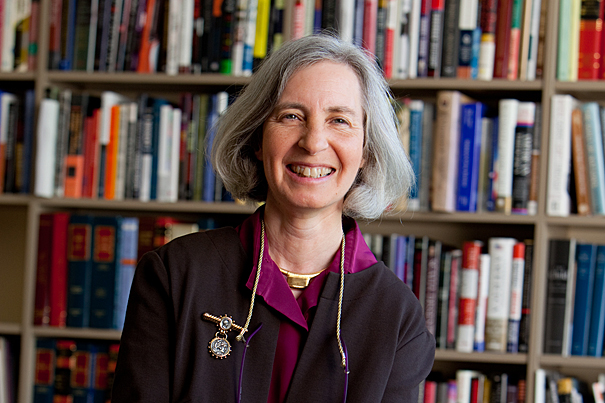
Dean of Harvard Law School Martha Minow witnessed segregation firsthand as a schoolgirl in Illinois and later in Washington, D.C. Now her new book “In Brown’s Wake” explores the repercussions of Brown v. Board of Education, which declared segregation unconstitutional, and, says Minow, “became a motor for educational improvement.”
Rose Lincoln/Harvard Staff Photographer
The golden ruling
Minow tackles the legacy of Brown v. Board of Education
Born the same year as the Supreme Court’s groundbreaking ruling in Brown v. Board of Education that declared segregation unconstitutional, Martha Minow saw such discrimination firsthand as a schoolgirl in Illinois and later in Washington, D.C.
Though desegregation became law, its enforcement wasn’t guaranteed. The 1964 Civil Rights Act eventually changed that, and Minow, now dean of Harvard Law School, said that as long as she can remember she’s been “engaged with the struggles over whether and how schools can offer equal opportunities and actually integrate students of different races and backgrounds.”
Now, Minow has published “In Brown’s Wake: Legacies of America’s Educational Landmark.” Saddened by many discussions emphasizing Brown’s shortcomings, Minow said she thought it was worth addressing its legacies, including some surprising ones.
“Inspired and guided by Brown, advocates since the early 1960s pursued equal schooling along lines of gender, disability, language, immigration, socioeconomic class, religion, and sexual orientation — and secured federal and state protections and significant programs in each area,” said Minow. “Brown also triggered movements for school choice — initially by people seeking to avoid racial desegregation, then by judges and school officials trying to achieve it, and now as a motor for educational improvement.”
Minow described how Brown stimulated social science research on the influences of contact across lines of social difference, which now deals with Palestinians and Israelis, Catholics and Protestants in Northern Ireland, and people connecting in online communities. “In fact, since 1954, Brown has offered a touchstone for social change entrepreneurs inside and beyond the United States,” she added.
But, Minow notes, issues of schooling and race have become more complicated since Brown’s passage.
“Over time, the legal principle of Brown was reinterpreted to ban any school assignment of a student using race — even when designed to produce racial integration,” she said. “Now it is less racial than economic differences that spell disparate educational opportunities; and it’s less a legal problem than a political one.”
Still, said Minow, “Brown broke the back of Jim Crow laws mandating racial exclusions and white supremacy. And the idea that all students deserve educational opportunity guides treatment of children with learning disabilities, developmental delays, and physical disabilities; recent immigrants and children learning English; and girls who now play soccer, study physics, and anything else boys study. All kids benefit from Brown’s vision of educational equal opportunity.”




